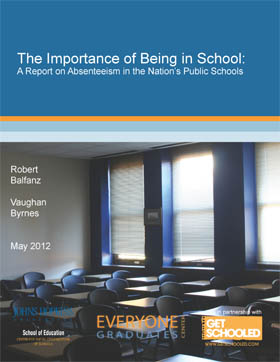 Over the past few years, much has been made of students’ “time in learning” (both more time on task while in class and more time in school each day or more days in school each year). Yet little attention has been paid to chronic absenteeism—missing more than 10 percent of a year’s school days—mainly because few states track these data. (Instead, they report average daily attendance, which can mask high levels of chronic absenteeism.) This exploratory study parses attendance data from six states (FL, GA, MD, NE, OR, and RI) and finds chronic absenteeism averaging 14 percent of students. (If this rate holds nationally, the U.S. has lots more students chronically absent—about seven million—than attend charter schools.) The report offers further data, bleak but not altogether surprising: Low-income students are most likely to miss a lot of school, as are the youngest and oldest students. High-poverty urban areas see up to a third of their students miss 10 percent of their courses each year (though the problem is seen in rural poor locations as well). But neither gender nor ethnicity appears to play a role in chronic absenteeism. Policymakers thinking through extended school days and years would be prudent to internalize this study’s message. More learning time will only be productive if the students are in class to take advantage of it.
Over the past few years, much has been made of students’ “time in learning” (both more time on task while in class and more time in school each day or more days in school each year). Yet little attention has been paid to chronic absenteeism—missing more than 10 percent of a year’s school days—mainly because few states track these data. (Instead, they report average daily attendance, which can mask high levels of chronic absenteeism.) This exploratory study parses attendance data from six states (FL, GA, MD, NE, OR, and RI) and finds chronic absenteeism averaging 14 percent of students. (If this rate holds nationally, the U.S. has lots more students chronically absent—about seven million—than attend charter schools.) The report offers further data, bleak but not altogether surprising: Low-income students are most likely to miss a lot of school, as are the youngest and oldest students. High-poverty urban areas see up to a third of their students miss 10 percent of their courses each year (though the problem is seen in rural poor locations as well). But neither gender nor ethnicity appears to play a role in chronic absenteeism. Policymakers thinking through extended school days and years would be prudent to internalize this study’s message. More learning time will only be productive if the students are in class to take advantage of it.
Robert Balfantz and Vaughn Byrnes, The Importance of Being in School: A Report on Absenteeism in the Nation’s Public Schools (Baltimore, MD: Johns Hopkins University, May 2012).
